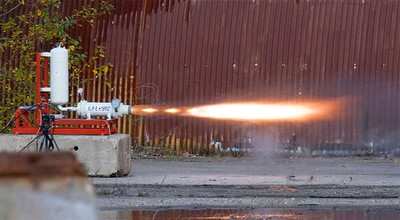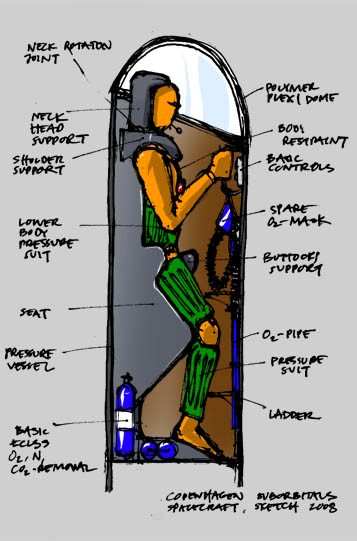Privately-Funded Danish Group Successfully Tests Booster
Rocket
A privately-funded suborbital space endeavor took another step
toward its goal to launch a one-manned spacecraft into space with
the October 19 test-firing of a hybrid rocket booster engine.

Copenhagen Suborbitals is currently developing a series of
suborbital space vehicles designed to validate and test
performance, paving the way for manned space flight on a micro-size
spacecraft, or MSC. "The mission has a 100% peaceful purpose and is
not in any way involved in carrying explosive, nuclear, biological
and chemical payloads," the CS website states. "We intend to share
all our technical information as much as possible, within the laws
of EU-export control."
Two rocket vehicles are under development: a small unmanned
sounding rocket, named Hybrid Atmospheric Test Vehicle, or HATV,
and a larger booster rocket named Hybrid Exo Atmospheric
Transporter, or HEAT, designed to carry a micro spacecraft into a
suborbital trajectory in space.
Both boosters systems will be hybrid rockets using epoxy as
solid propellant.
The HATV is a 1/3 scale rocket with a 200 mm diameter tube that
will function as a basic flight test model. The oxidizer for the
HATV will be nitrous oxide. This rocket is currently being
constructed, and the hold-down booster is undergoing pre-launch
testing.
The HATV booster is set to be launched from southern Norway.
The HEAT is a real-scale rocket with a 630 mm diameter tube that
will function as the final test rocket. The oxidizer for the HEAT
will be liquid oxygen (LOX).
The HEAT booster will burn for about 60 seconds, providing 40kN
of thrust and resulting in less than 3-g, making the trip feasible
for humans to endure.
Currently, the HEAT booster is set to be launched from Iceland.
"We have established contact the Icelandic Government and are
trying to find the best spot for launch and recovery."
The HEAT booster will serve as the transportation vehicle for
the MSC, a pressurized capsule providing support for one upright
standing/half-sitting person. A polymer Plexiglas-dome provides a
full view to experience the entire ballistic ride.
"Based on the expected flight data and future test-flights,
g-force loads and rocket orientation, we will determine the seating
construction and necessary support to ensure safe human
travel."
Before the spacecraft goes into a zero gravity parabola, the
booster system will be jettisoned. After a while of atmospheric
re-entry, the spacecraft will be slowed by two episodes of deployed
parachutes. Finally, the spacecraft will touchdown on land.
It will not be possible for the astronaut to move around inside
the MSC. Only the arms will be free "to operate a few (backup)
systems like grabbing on to handles or a vomit bag, as well as
additional oxygen mask and the MSC abort system, if necessary after
touchdown."
While strapped in, the head may be able to slightly turn
sideways to provide a wider outlook, and the astronaut will be
equipped with a small emergency parachute which will be fitted into
the seating system.

The MSC will be required to have a simple environmental control
and life support system, to support the astronaut for the flight
and an additional 24 hours. To control the orthostatic pressure, a
pressure suit will be used.
The avionics system of the MSC will be flight controller systems
or trajectory calculation devices, either guiding the rocket or
providing ground personnel with a position to assist with the pick
up of the astronaut and jettisoned booster.
"We don't use any attitude controllers or mechanical guidance on
our boosters. The system is very basic and will rely completely on
the laws of aerodynamics."
 NTSB Final Report: Rutan Long-EZ
NTSB Final Report: Rutan Long-EZ ANN FAQ: Turn On Post Notifications
ANN FAQ: Turn On Post Notifications Classic Aero-TV: ICAS Perspectives - Advice for New Air Show Performers
Classic Aero-TV: ICAS Perspectives - Advice for New Air Show Performers ANN's Daily Aero-Linx (06.28.25)
ANN's Daily Aero-Linx (06.28.25) Aero-News: Quote of the Day (06.28.25)
Aero-News: Quote of the Day (06.28.25)




